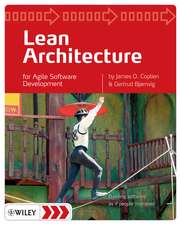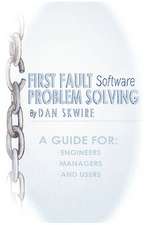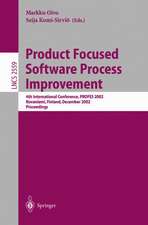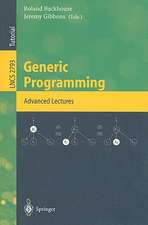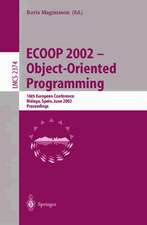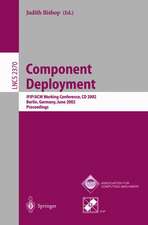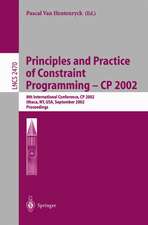Feature-Oriented Software Product Lines: Concepts and Implementation
Autor Sven Apel, Don Batory, Christian Kästner, Gunter Saakeen Limba Engleză Hardback – 9 oct 2013
The authors take a developer’s viewpoint, focus on the development, maintenance, and implementation of product-line variability, and especially concentrate on automated product derivation based on a user’s feature selection. The book consists of three parts. Part I provides a general introduction to feature-oriented software product lines, describing the product-line approach and introducing the product-line development process with its two elements of domain and application engineering. The pivotal part II covers a wide variety of implementation techniques including design patterns, frameworks, components, feature-oriented programming, and aspect-oriented programming, as well as tool-based approaches including preprocessors, build systems, version-control systems, and virtual separation of concerns. Finally, part III is devoted to advanced topics related to feature-oriented product lines like refactoring, feature interaction, and analysis tools specific to product lines. In addition, an appendix listsvarious helpful tools for software product-line development, along with a description of how they relate to the topics covered in this book.
To tie the book together, the authors use two running examples that are well documented in the product-line literature: data management for embedded systems, and variations of graph data structures. They start every chapter by explicitly stating the respective learning goals and finish it with a set of exercises; additional teaching material is also available online. All these features make the book ideally suited for teaching – both for academic classes and for professionals interested in self-study.
| Toate formatele și edițiile | Preț | Express |
|---|---|---|
| Paperback (1) | 419.58 lei 6-8 săpt. | |
| Springer Berlin, Heidelberg – 23 aug 2016 | 419.58 lei 6-8 săpt. | |
| Hardback (1) | 594.64 lei 6-8 săpt. | |
| Springer Berlin, Heidelberg – 9 oct 2013 | 594.64 lei 6-8 săpt. |
Preț: 594.64 lei
Preț vechi: 743.30 lei
-20% Nou
Puncte Express: 892
Preț estimativ în valută:
113.80€ • 123.57$ • 95.59£
113.80€ • 123.57$ • 95.59£
Carte tipărită la comandă
Livrare economică 22 aprilie-06 mai
Preluare comenzi: 021 569.72.76
Specificații
ISBN-13: 9783642375200
ISBN-10: 3642375200
Pagini: 330
Ilustrații: XVI, 315 p. 63 illus., 11 illus. in color.
Dimensiuni: 155 x 235 x 25 mm
Greutate: 0.59 kg
Ediția:2013
Editura: Springer Berlin, Heidelberg
Colecția Springer
Locul publicării:Berlin, Heidelberg, Germany
ISBN-10: 3642375200
Pagini: 330
Ilustrații: XVI, 315 p. 63 illus., 11 illus. in color.
Dimensiuni: 155 x 235 x 25 mm
Greutate: 0.59 kg
Ediția:2013
Editura: Springer Berlin, Heidelberg
Colecția Springer
Locul publicării:Berlin, Heidelberg, Germany
Public țintă
GraduateCuprins
Part I Software Product Lines.- Software Product Lines.- A Development Process for Feature-Oriented Product Lines.- Part II Variability Implementation.- Basic Concepts, Classification, and Quality Criteria.- Classic, Language-Based Variability Mechanisms.- Classic, Tool-Driven Variability Mechanisms.- Advanced, Language-Based Variability Mechanisms.- Advanced, Tool-Driven Variability Mechanisms.- Part III Advanced Topics.- Refactoring of Software Product Lines.- Feature Interactions.- Analysis of Software Product Lines.- Tool Support.
Recenzii
“The book provides a systematic introduction to feature-oriented software product lines, and leads the reader to more advanced topics in its second half. The authors distill the concepts and principles underlying the field with remarkable clarity, providing a much-needed foundation for the field. They also illustrate these concepts and principles using concrete examples, showcasing
languages, tools, and systems from both industrial practice and latest research. (…) There is no better team than these four authors to write about feature-oriented software product lines. The authors have made fundamental scientific and engineering contributions to the field.” from the foreword by Krzysztof Czarnecki, University of Waterloo, Canada
languages, tools, and systems from both industrial practice and latest research. (…) There is no better team than these four authors to write about feature-oriented software product lines. The authors have made fundamental scientific and engineering contributions to the field.” from the foreword by Krzysztof Czarnecki, University of Waterloo, Canada
Notă biografică
Sven Apel is the leader of the Software Product-Line Group at the University of Passau, Germany. His research interests include novel programming paradigms, software engineering and product lines, and formal and empirical methods. He is the author or coauthor of over a hundred peer-reviewed scientific publications. His work has received awards from the Ernst Denert Foundation and the Karin Witte Foundation.
Don Batory is a Professor at the Department of Computer Science, University of Texas at Austin, TX, USA. His initial interests were in relational database implementation, and gradually expanded into product-line architectures, software generators, transformation systems, and object-oriented refactoring. He is among the pioneers of feature-oriented software product-lines, and has given many tutorials on this topic at premier conferences over the last 15 years.
Christian Kästner is an Assistant Professor in the School of Computer Science at Carnegie Mellon University, Pittsburgh, PA, USA. His research focuses on ensuring correctness and supporting understanding of systems with variability, often with a focus on large scale and pragmatic solutions. He is the author or coauthor of over a hundred peer-reviewed scientific publications. For his PhD thesis, he received the German Computer Science Society’s Best Dissertation Award 2010.
Gunter Saake is a Professor of Computer Science at the Otto-von-Guericke-University in Magdeburg, Germany. He has authored more than 200 publications covering several areas of database management, formal methods and software engineering, as well as several graduate textbooks on Java, on database technology, and a general introductory book for computer science students.
Don Batory is a Professor at the Department of Computer Science, University of Texas at Austin, TX, USA. His initial interests were in relational database implementation, and gradually expanded into product-line architectures, software generators, transformation systems, and object-oriented refactoring. He is among the pioneers of feature-oriented software product-lines, and has given many tutorials on this topic at premier conferences over the last 15 years.
Christian Kästner is an Assistant Professor in the School of Computer Science at Carnegie Mellon University, Pittsburgh, PA, USA. His research focuses on ensuring correctness and supporting understanding of systems with variability, often with a focus on large scale and pragmatic solutions. He is the author or coauthor of over a hundred peer-reviewed scientific publications. For his PhD thesis, he received the German Computer Science Society’s Best Dissertation Award 2010.
Gunter Saake is a Professor of Computer Science at the Otto-von-Guericke-University in Magdeburg, Germany. He has authored more than 200 publications covering several areas of database management, formal methods and software engineering, as well as several graduate textbooks on Java, on database technology, and a general introductory book for computer science students.
Textul de pe ultima copertă
While standardization has empowered the software industry to substantially scale software development and to provide affordable software to a broad market, it often does not address smaller market segments, nor the needs and wishes of individual customers. Software product lines reconcile mass production and standardization with mass customization in software engineering. Ideally, based on a set of reusable parts, a software manufacturer can generate a software product based on the requirements of its customer. The concept of features is central to achieving this level of automation, because features bridge the gap between the requirements the customer has and the functionality a product provides. Thus features are a central concept in all phases of product-line development.
The authors take a developer’s viewpoint, focus on the development, maintenance, and implementation of product-line variability, and especially concentrate on automated product derivation based on a user’s feature selection. The book consists of three parts. Part I provides a general introduction to feature-oriented software product lines, describing the product-line approach and introducing the product-line development process with its two elements of domain and application engineering. The pivotal part II covers a wide variety of implementation techniques including design patterns, frameworks, components, feature-oriented programming, and aspect-oriented programming, as well as tool-based approaches including preprocessors, build systems, version-control systems, and virtual separation of concerns. Finally, part III is devoted to advanced topics related to feature-oriented product lines like refactoring, feature interaction, and analysis tools specific to product lines. In addition, an appendix listsvarious helpful tools for software product-line development, along with a description of how they relate to the topics covered in this book.
To tie the book together, the authors use two running examples that are well documented in the product-line literature: data management for embedded systems, and variations of graph data structures. They start every chapter by explicitly stating the respective learning goals and finish it with a set of exercises; additional teaching material is also available online. All these features make the book ideally suited for teaching – both for academic classes and for professionals interested in self-study.
The authors take a developer’s viewpoint, focus on the development, maintenance, and implementation of product-line variability, and especially concentrate on automated product derivation based on a user’s feature selection. The book consists of three parts. Part I provides a general introduction to feature-oriented software product lines, describing the product-line approach and introducing the product-line development process with its two elements of domain and application engineering. The pivotal part II covers a wide variety of implementation techniques including design patterns, frameworks, components, feature-oriented programming, and aspect-oriented programming, as well as tool-based approaches including preprocessors, build systems, version-control systems, and virtual separation of concerns. Finally, part III is devoted to advanced topics related to feature-oriented product lines like refactoring, feature interaction, and analysis tools specific to product lines. In addition, an appendix listsvarious helpful tools for software product-line development, along with a description of how they relate to the topics covered in this book.
To tie the book together, the authors use two running examples that are well documented in the product-line literature: data management for embedded systems, and variations of graph data structures. They start every chapter by explicitly stating the respective learning goals and finish it with a set of exercises; additional teaching material is also available online. All these features make the book ideally suited for teaching – both for academic classes and for professionals interested in self-study.
Caracteristici
Takes a dedicated development-oriented view, focusing on automatic product derivation based on feature selection Broad and unbiased presentation of classic as well as tools, novel implementation techniques, and programming paradigms Includes a broad classification of tools and techniques for all stages of the development process and a detailed discussion of tradeoffs Tied together by two running examples, one relevant for academic and one for industrial applications Combined author team of experienced pioneers in software product line development Includes supplementary material: sn.pub/extras

